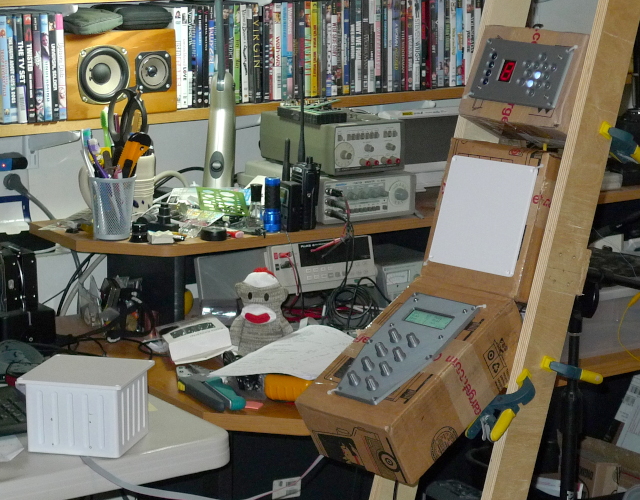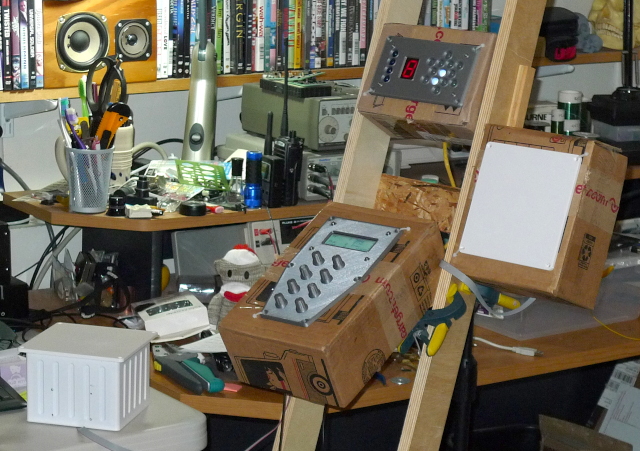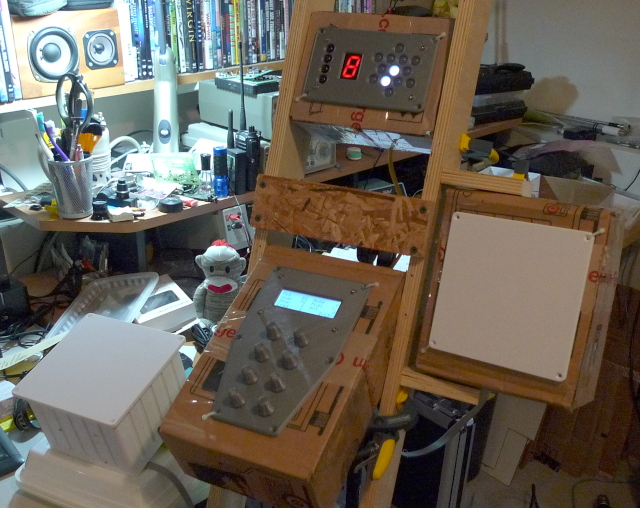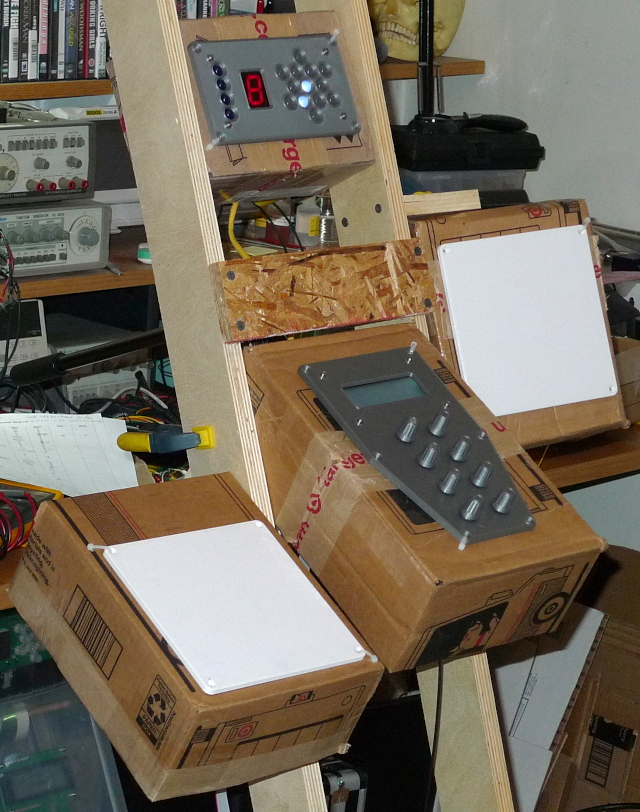I was looking to see if the high/low for the pitch/volume respectively was not working out for you. My D-Lev II is based on that form because I thought it was a good idea at the time, and I still hope that it is (because I have a lot of parts for that style). I doesn't sound like that is one of your issues, though?
Let's Design and Build a (mostly) Digital Theremin!
"I was looking to see if the high/low for the pitch/volume respectively was not working out for you. My D-Lev II is based on that form because I thought it was a good idea at the time, and I still hope that it is (because I have a lot of parts for that style). I doesn't sound like that is one of your issues, though?" - pitts8rh
The high/low, back/front thing is a good configuration that I will be retaining for P3, just differently.
P3 will be a single bent tube slightly off to the right, consisting of the controls / LCD lowest and nearest (~45 degrees), an upward bend to ~perpendicular to the floor, then pitch plate, and finally tuner at the top, both ~co-planar. Volume plate off to the left side and lower, parallel to the floor. I hope to test out this configuration in the next day or so. It may be possible to have the volume plate mount pivot from the rest of the body, making it ambidextrous.
P3 Ergonomic Escapades
Mounted the sub-assemblies in cut down cardboard boxes, made a stick skeleton mounted on a boom mic stand, and tried a couple of arrangements today:

The first configuration (above) I thought would totally fly, but it ended up feeling awkward having the pitch plate so centered up with the tuner and controls. I kept catching myself playing the plate off-center to the right. Force of habit from P1 & P2?

The pitch plate feels more natural located off to the right in the second configuration (above), and the controls feel better too being raised somewhat higher. A couple of sticks help to angle the pitch plate in somewhat, but this definitely needs more experimentation.
Some paint stirring sticks are currently gluing in the control box to help me try some variations on this second configuration. The volume plate needs a formal mount of some sort, though the height, angle, and location feel pretty fine with it simply perched on my desk (definitely not a solution). Already P3 seems like an improvement over P1 & P2 (though lord only knows how to build the wacky enclosure).
You just never know with this stuff, going where no man has gone before (Theremin, the final frontier...).
More P3
Added a couple of sticks to hold the pitch plate box, which allowed me to angle it in a little and move the controls up a tad:

Turned my back on it for a second and it hit the floor, breaking the volume plate center post and spilling its guts out. Two hours later had another post printed, this time with 5 outer layers and 50% infill. Also flipped the mic stand cross brace to the front to improve balance.
The volume plate seems to work well by angling it the same as the control unit, and about the same distance away from center as the pitch plate. Need to mount it in a cardboard box and get it off my desk.
So I'm playing again! Minnie Riperton (she could hit F#7! - RIP) says merry x-mas: [MP3]
An octave lower: [MP3]. I should stop posting songs I've only played a few times (though I made it through that one in one take).
Add a few inches to the width and you have a nice sloped-panel equipment rack for your reverb, equalizer, etc. right where they are convenient! Actually this could mark the end to the usual wobbly spindly theremin stand. As I think about it the idea of a theremin workstation, at least for practicing in seclusion where appearance is not an issue maybe isn't a bad idea. You could have the first real rack-mount theremin (ignoring the modular Eurorack playthings out there). After all, I've wanted to turn a recliner into a theremin for some time. Comfort and convenience in our old age...
Repeatability > Configurability
Muscle memory is completely unforgiving. Just changing the height of a given Theremin by 1" noticeably changes the feel. So even if you can hinge stuff or articulate whatever, you still need a way to get everything in more or less exactly the same place it was last time, or you'll be forever acclimating to slightly new & different setups. So the goal is to come up with a physical arrangement of elements that is comfortable for the majority of players. Or punt and just mount everything is a shoe box with some plumbing fixtures - but then I probably wouldn't want to play it, which would be disastrous for development (I already don't play enough and so don't need discouragement in that department).
Mounted the volume plate in a box and clamped it to the wood frame:

It needs a couple of sticks like the pitch plate has, mainly to space it out a bit more from the frame.
Literally nothing is co-planar, which isn't exactly making me happy - I was really hoping for a lot more in the way of synergy with the ergonomics. Not to overstate it, but makes me feel rather powerless, like when an analog circuit doesn't work well no matter what I do. One could construct the cabinet from paper mache (and take it outside and beat it like a pinata on holidays ;-) but how do you transport such a monstrosity? The plates could hinge, but then you get exposed wiring flexing all over the place / jacks & plugs / etc. It's almost as bad as a cello, and I'd like to keep it down to around the size of an acoustic guitar.
Will play it for a while, while I ponder some more. It's still somewhat difficult to acal as the plates are close to the controls, but overall it's better than P1 or P2 to play. I don't notice my pitch hand wandering off the center of the plate, and the volume plate is similarly easy to play.
If this whole exercise seems really boring and drawn-out, that's because it is! ;-)
"Add a few inches to the width and you have a nice sloped-panel equipment rack for your reverb, equalizer, etc. right where they are convenient! - pitts8rh
True! But might make the thing unbalanced.
"Actually this could mark the end to the usual wobbly spindly theremin stand."
Stands need more than 3 legs, this one dumped poor P3 on the ground. I've got a 5-legger, but the legs are a lot shorter. Falling Theremins are a disaster, I can see why a lot of folks replace the EPro stand with something less tippy.
"As I think about it the idea of a theremin workstation, at least for practicing in seclusion where appearance is not an issue maybe isn't a bad idea. You could have the first real rack-mount theremin (ignoring the modular Eurorack playthings out there)."
There's got to be some way to make it portable too. Paper mache could at least be fairly light weight...
[EDIT] The plates and control unit are fairly contiguous, maybe do that as one thing have the tuner on a stalk...
MIDI Is Percussive
I thought the pitch side of a MIDI Theremin controller would be the most involved, but the volume side is probably trickier. MIDI note-on wants a velocity for the note it is activating, but the Theremin doesn't generally operate as a percussive instrument. The note-on velocity is a timbre selector for sounds such as piano, so I don't think you can just send it vel=64 and do volume modulation afterward.
MIDI may be why things like the Linnstrument tend to be demoed with semi-percussive instrument voices such as violin.
I'm still reviewing the Open.Theremin MIDI implementation. It appears to calculate velocity past a certain point in space.
"I'm still reviewing the Open.Theremin MIDI implementation. It appears to calculate velocity past a certain point in space." - Dewster
Would it make sense to have a running list of volume-hand velocity data (whether you are in the audible range or not) and then grab the most recent velocity number for the note-on information at trigger time (whenever that is)? The harder question seems to be when you decide to send the note-on information. I don't know if you'd want to trigger all notes in the audibility range. It wouldn't work to trigger high-velocity percussive sounds when the volume is down, so you pretty much need to recognize a fast hand movement and delay the trigger until a certain threshold is reached. But at the same time you can't have delayed triggering of low-velocity notes that you want to be already playing as you barely skirt audibility. I just wonder how all of this would affect the theremin feel.
I think you're right that volume is probably trickier than the pitch, although merging pitch-bent notes (when you've run out of bend range) with newly-triggered notes has to be done right and is going to weed out the use of traditional synthesizers in many cases.
I did score a Black Friday special on the AudioModeling SWAM solo strings software set, but I haven't had a chance to try it with the LinnStrument yet. I'm curious about how this stuff all works, but hopefully it doesn't have the same problems that sample players have with pitch bends and transitions.
Is it really MIDI, or the insturments that are typically used? I mean you said "is a timbre selector" - for attack, I presume.
That's not due to MIDI, though?
Altering the volume might work withz aftertouch, channel volume, or expression, or any mappable control change - maybe all of those selectable to cover every possible target.
Heh. Could you calculate actual *velocity* to use that, in a certain mode of playing, I mean the velocity of approximation of hte volume hand, measuring the movement and if it goes below a certain distance threshold, it triggers? And with a certain minimum length of movement to be a valid trigger, "hysteresis".
After it has triggered, movements further away than the trigger distance could be used to further modulate volume after the NoteOn.
No idea of how playable that could be.
You'd need to both, monitor hand movements for ongoing note volume modulation, but also evaluate the speed, to be ready for a re-trigger once the threshold gets passed again.
"Would it make sense to have a running list of volume-hand velocity data (whether you are in the audible range or not) and then grab the most recent velocity number for the note-on information at trigger time (whenever that is)?" - pitts8rh
They've got a SW timer going that fires every ~3ms and updates all the MIDI stuff. A MIDI command of 3 bytes takes ~1ms to TX, and often multiple command & CC are sent out per update. They keep a variety of old position, etc. values around for change detection, velocity, and other calculations.
"The harder question seems to be when you decide to send the note-on information. I don't know if you'd want to trigger all notes in the audibility range. It wouldn't work to trigger high-velocity percussive sounds when the volume is down, so you pretty much need to recognize a fast hand movement and delay the trigger until a certain threshold is reached. But at the same time you can't have delayed triggering of low-velocity notes that you want to be already playing as you barely skirt audibility. I just wonder how all of this would affect the theremin feel."
Yeah, that's the thing. I must really depend on the voice category how you might best handle the actual note-on. Their code is constantly modulating the volume loop CC when a note is active.
"I think you're right that volume is probably trickier than the pitch, although merging pitch-bent notes (when you've run out of bend range) with newly-triggered notes has to be done right and is going to weed out the use of traditional synthesizers in many cases."
MIDI itself seems to be extremely keyboard oriented. Which is by its very nature percussive.
"I did score a Black Friday special on the AudioModeling SWAM solo strings software set, but I haven't had a chance to try it with the LinnStrument yet. I'm curious about how this stuff all works, but hopefully it doesn't have the same problems that sample players have with pitch bends and transitions."
The LinnStrument and the Continuum - working with advanced SW synths - must have blazed much of this MIDI control trail in the first place.
"Is it really MIDI, or the insturments that are typically used? I mean you said "is a timbre selector" - for attack, I presume. That's not due to MIDI, though?" - tinkeringdude
Digital pianos and sample sets typically pick one of many recordings of a single note based on the key velocity. The timbre can vary quite a bit depending on how hard the key is pressed, so it is sort of an attack thing, but not entirely. MIDI, with note-on and velocity linked together, seems to be highly geared towards this sort of percussive / initial "ping" and let it roll type arrangement.
"You'd need to both, monitor hand movements for ongoing note volume modulation, but also evaluate the speed, to be ready for a re-trigger once the threshold gets passed again."
Initially anyway, it seems like a can of worms. Something you might find the secret combination to getting it working OK for one synth and have it fall flat on its face for another.
A lot of MIDI seems pretty vague, like it doesn't specify dB change for volume - probably both a strength and a weakness.
The Open.Theremin transmits 7 bit CC data for the volume loop and 14 bit CC data for the pitch rod.
You must be logged in to post a reply. Please log in or register for a new account.


